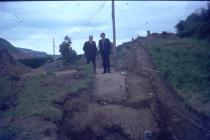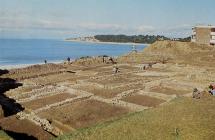Content can be downloaded for non-commercial purposes, such as for personal use or in educational resources.
For commercial purposes please contact the copyright holder directly.
Read more about the The Creative Archive Licence.
Description
Pottery fragments recovered from the cursus complex at Sarn-y-Bryn-Caled, south of Welshpool. The pottery fragments were recovered from the cremated remains of a secondary burial at the site and appear to be part of a middle / late Neolithic vessel in the Peterborough style.
The cursus complex at Sarn-y-Bryn-Caled is a long, rectangular ditched enclosure about 10 metres wide and 400 metres long. It had banks on the outside of the ditches and had been dated to the Neolithic period about 3,700 BC. The purpose of th cursus is obscure, but it appears to have been a ritual site. The cursus attracted other ritual and burial sites. Ring ditches, ploughed-out burial mounds, cluster around its northern end and there is also a large ritual enclosure or 'henge' monument partly underlying Mill Lane.
The construction of the Welshpool by-pass prompted the excavation of some of the components of the cursus complex. A small penannular ditch to the south-east of the complex produced four human cremation burials and fragments of late Neolithic Peterborough Pottery. Radiocarbon dates of c. 2900 BC were obtained for the site. The ring ditches of Coed-y-Dinas produced more than thirty vessels of Beaker pottery and dates of 1900 BC.
The most spectacular monument so far excavated was the timber circle at Sarn-y-Bryn-Caled. This was a double circle of large oak posts standing about 4 metres high. An entrance faced south suggesting the possibility of sun worship or orientation. A central burial pit contained two human cremation burials; one was associated with a small Bronze Age food vessel pot (as shown here) and the other, the primary burial, appeared to be a human sacrifice as four high quality barbed and tanged flint arrowheads were found in the burial and had probably been the cause of death. This practice can be paralleled at Stonehenge.
Description: Powysland Museum and Montgomery Canal Centre






Do you have information to add to this item? Please leave a comment
Comments (0)
You must be logged in to leave a comment